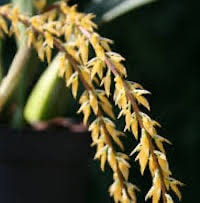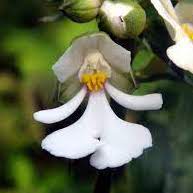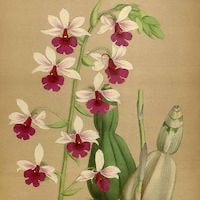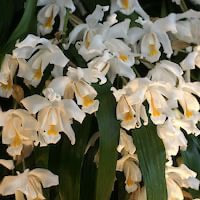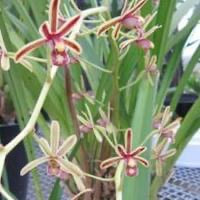WFR7- Women's Fresh 7 - We're mint to be
|
Native Singaporean Orchid notes: Bulbophyllum Vaginatum
Gymnadenia conopsea, known as the fragrant orchid, is a plant native to northern Europe but now found in collections in Singapore due to its pleasant scent. It holds significant medicinal value, widely used across cultures. In Chinese, it’s called shou shen (hand ginseng), Shouzhangshen (Palm ginseng), Foshoushen (Buddha hand ginseng), and Zhangshen (palm ginseng), while in Japanese it's Tegata-chidori. Oil extraction has revealed key compounds like dactylorhins A and B, loroglossin, and militarine, with no alkaloids found. It’s traditionally used to treat weakness, cough, breathlessness, bloody diarrhea, and external injuries.
|
Therapeutic Orchid notes:
|
Bulbophyllum rufinum
Bulbophyllum rufinum, known by various Thai names such as Ma tak khok, Ueang kip ma ya, hang krarok, and om hin in Ubon Rachthani, is valued not only for its medicinal properties but also for its fragrance. The entire plant is used traditionally in Thailand as a tonic and to alleviate asthma. Its aromatic qualities likely contribute to its use in traditional medicine, providing both therapeutic benefits and sensory delight. |
|
Calanthe alismifolia Lindl. and Calanthe nigropuncticulata Fukuyama
Calanthe alismifolia Lindl. and Calanthe nigropuncticulata Fukuyama, known as Zexiexiaji Lan and Xidiangenjie Lan in Chinese, and black-spotted Calanthe and white flower Calanthe in Taiwan, are utilized in Chinese traditional medicine under the name Zongyeqi. Harvested in summer and autumn, these orchids are sun-dried for medicinal use. They are prescribed in decoctions for their acrid, bitter taste, believed to cool the body, reduce fever, detoxify, relieve gas, resolve blood stasis, reduce swelling, improve blood circulation, and aid in healing ulcers and injuries. |
|
Calanthe vestita Wall ex Lindl.
Calanthe vestita Wall ex Lindl., known as Khao Malila in Thai and Thazin gyi ahphyu in Myanmar, is valued in traditional medicine for its diverse medicinal properties. It is used across Asia to reduce blood stasis, improve circulation, and detoxify the body. In Chinese herbal medicine, it treats swellings from abscesses, trauma, arthritis, and joint pain, while fortified wines made from its roots aid in healing injuries and internal bleeding. Phytochemical studies reveal flavone C-glycosides in its leaves, and in Vietnam, crushed bulbs are used for rheumatism. Calanthe species also show potential as hair-restorers and anticancer agents due to compounds like calanquinone A, effective against various cancer types by inducing apoptosis and cell cycle arrest. |
|
Coelogyne cristata Lindl. Coelogyne speciosissmum D. Don
Coelogyne cristata and Coelogyne speciosissmum, known as Beimu Lan in Chinese and Hadjojen in Indian, are orchids found in Nepal, Bhutan, northern India, Bangladesh, Tibet, and Myanmar. Coelogyne cristata's ethanolic extract shows strong antibacterial activity against Staphylococcus aureus and moderate activity against Escherichia coli. It contains coelogin, coeloginin, and novel 9,10-dihydrophenanthrene derivatives with phytoalexin properties. Traditionally, these orchids treat fractures in animals in the Himalayas, dysentery in Myanmar, and constipation in Nepal. Additionally, Nepalese use them as aphrodisiacs and apply pseudobulb juice on animal hooves for boils and wounds, aligning with their local medicinal traditions. |
|
Cymbidium crassifolium Herb. Syn. Cymbidium mannii Rchb.
Cymbidium crassifolium Herb., known as "Rouye Lan" or tender leaf Cymbidium in Chinese, is a medicinal orchid collected from Guangxi and Yunnan provinces in China. Its leaves are traditionally used for their therapeutic benefits, particularly in treating fractures. Similar species like Cymbidium bicolor are also utilized for bone healing in traditional medicine. These orchids are valued for their potential in aiding recovery from bone injuries, although specific methods of preparation and administration can vary across different medicinal practices. |
Other scent note
Scentopia Library Reference ingredient
Honeydew113- Honeydew - Check details at Scentopia's scent library
Download the guided mediation that works best with this Orchid fragrance oil
| women_fresh_essential_oil_orchi_00007.mp3 | |
| File Size: | 115667 kb |
| File Type: | mp3 |

